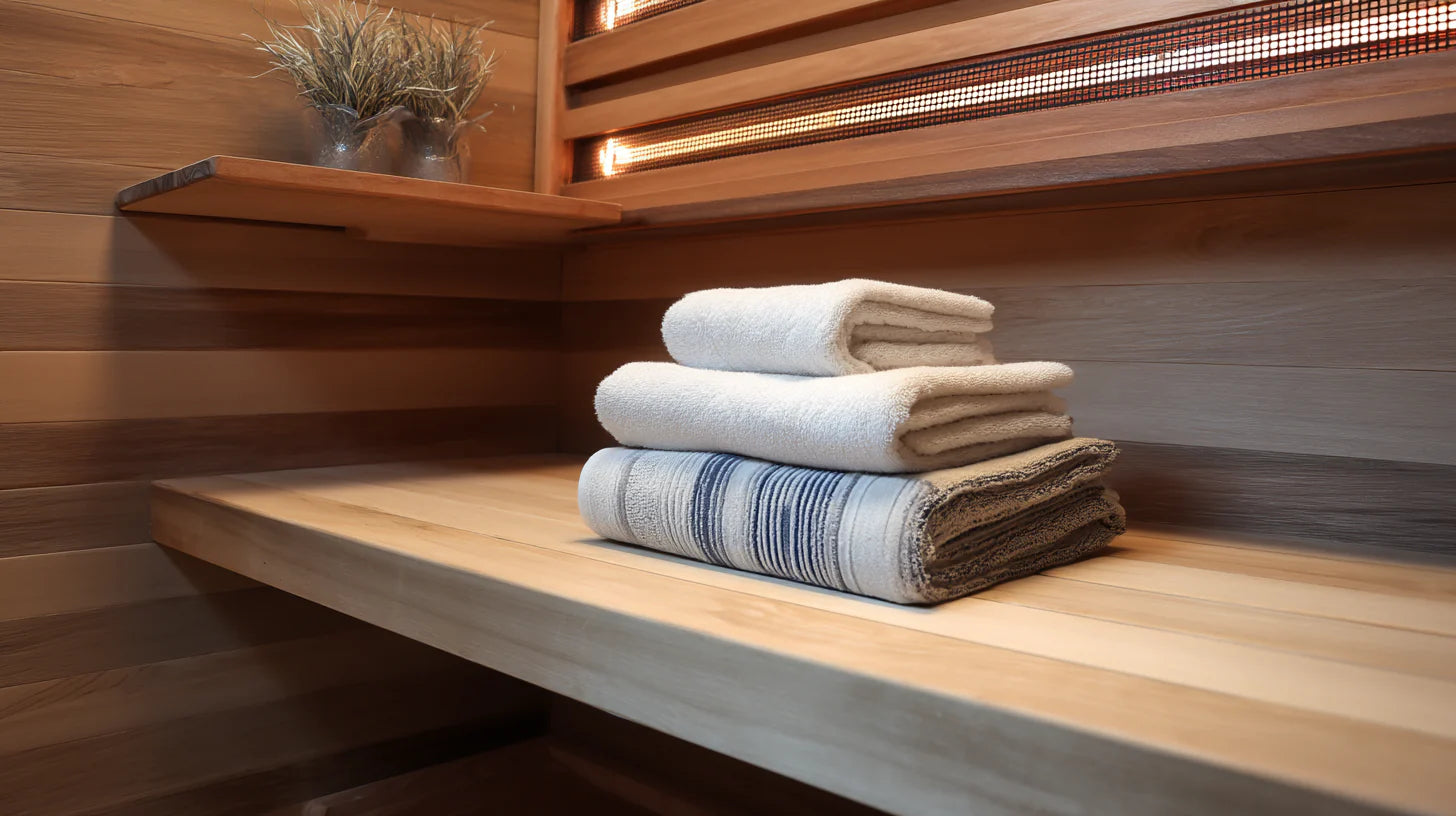A sauna is more than a place to sweat, it is a sanctuary of warmth, tradition, and restoration. In a traditional sauna or a wood fired sauna, the wood itself defines much of the sauna experience. The way cedar wood smells under heat, the way sauna benches feel against the skin, and the way the walls hold and radiate warmth all contribute to the atmosphere. To keep your sauna in pristine condition and ensure it works properly for years, you need to understand how to clean sauna wood with proper maintenance techniques that respect its natural beauty.
This complete guide will show you everything you need to know, from daily light cleaning to deeper cleaning sessions that address stubborn stains and sweat stains. You will learn how to use natural products like baking soda, how to protect the sauna interior with wood penetrating oil, and how to care for both benches walls and floors. Whether you own a Kyfe portable sauna, a stationary cabin sauna, or even prefer infrared saunas or electric heaters, this guide will help you master sauna cleaning with elegance and efficiency.
Why Sauna Wood Care Matters

The wood inside your sauna is not just a design element, it is a functional surface that interacts with heat, moisture, and steam bath conditions every time you step inside. Without proper sauna maintenance, sweat, minerals, and dirt can build up on the surface, leading to discoloration and unpleasant odors. Excess moisture can seep into the grain, encouraging mold growth and weakening the structure over time. High temperatures accelerate these effects, making preventative measure routines essential.
Cedar wood, often used for sauna benches and walls, naturally resists rot, but even cedar needs regular cleaning to maintain its durability. Other types of sauna wood such as Nordic spruce, aspen, or hemlock have their own care requirements, but all benefit from similar cleaning methods.
Understanding Your Sauna Wood
Before you clean sauna interiors, know the type of wood you are working with. Cedar wood gives a classic scent and warmth, while spruce and aspen offer lighter tones and smooth grain. The porous nature of sauna wood means it should never be coated with a wood sealant that traps moisture. This breathability allows the sauna to release extra moisture after sauna sessions, preventing damage.
Most saunas are designed with untreated interior wood, which allows it to absorb sweat and release it during drying. This natural cycle can be supported through good wood maintenance and periodic cleaning.
Routine After-Use Rituals for Clean Sauna Wood
Post-Session Wipe-Down
At the end of your sauna sessions, use a damp cloth to wipe down benches, backrests, and walls where skin contact occurs. This quick light cleaning removes sweat and superficial dirt before it can cause stains. Keeping the sauna benches clean after each use is a simple preventative measure that saves time during deeper cleaning later.
Ventilation and Drying
Once cleaning is done, leave the sauna door open for at least 15 minutes to allow moisture to escape. In portable models like the Kyfe tent sauna, you can open lower air vents to enhance airflow. This helps remove dirt particles from the air, reduce relative humidity, and prevent excess moisture from settling into the wood.
Quick Brush Tradition
Many traditional sauna owners keep a soft brush inside. The final person to leave gives benches walls and floors a quick scrub with warm water. This removes superficial dirt and sweat without chemicals, making sauna care a shared part of the sauna experience.
Deep Cleaning Sauna Wood: Monthly and Seasonal
Monthly cleaning ensures your sauna interior stays in pristine condition. Deep cleaning addresses build up from sweat, dirt, and steam, and is also the time to tackle stubborn stains.
Step 1 – Cool Down Completely
Allow the sauna to cool fully. Even in a dry sauna, lingering heat can cause cleaning water to evaporate too quickly, leaving marks.
Step 2 – Remove Loose Dirt
Sweep or vacuum floors and interior areas to remove dirt particles. A handheld vacuum works well for reaching corners under sauna benches. Periodically check behind heaters for build up of dust or debris.
Step 3 – Gentle Washing
Prepare a solution of warm water and mild soap or baking soda. Use a soft brush to scrub along the wood grain, avoiding excessive water that could create extra moisture. For electric heaters and sauna stones, follow manufacturer guidelines and wear gloves when handling them.
Step 4 – Tackling Sweat Stains and Stubborn Stains
Sweat stains can be lifted using a paste of baking soda and water. Apply gently with a soft brush, rinse with warm water, and wipe dry with a soft towel. Stubborn stains may require fine grit sandpaper. Lightly sand along the grain to restore the surface. For sanding benches, use 150–180 grit sandpaper to avoid roughening the wood.
Step 5 – Caring for Sauna Stones and Heater Units
Sauna stones should be removed and soaked in warm water periodically. This removes dirt particles and mineral deposits. For wood fired sauna furnaces, vacuum out ash and wipe down exterior wood sections. For electric heaters, disconnect power before cleaning.
Annual Restoration and Protective Treatments

Once a year, lightly sand benches walls and floors to remove minor surface damage. This also prepares the wood for optional treatments like wood penetrating oil. Applying oil can improve resistance to moisture and stains, although it will change the appearance of cedar wood or other sauna woods. Avoid varnish or paint, as these trap moisture and can produce toxic fumes under high temperatures.
Cleaning Do’s and Don’ts
Do's
-
Do use natural products like baking soda or lemon juice for cleaning.
-
Do keep sauna door open after cleaning to release extra moisture.
-
Do follow proper maintenance schedules with routine checks.
Don't's
-
Don’t use pressure washing, which can damage the sauna interior.
-
Don’t apply a wood sealant that traps moisture.
-
Don’t ignore sweat stains or build up, as they get harder to remove.
Maintaining Hygiene Without Harsh Chemicals
Natural products are safest for sauna cleaning. Pine-based soaps are traditional in Finland, and diluted vinegar can help control odors. Essential oils can be used by adding a few drops to water before pouring over sauna stones. Never apply oils directly to sauna benches or walls.
Preventive Practices for a Cleaner Sauna

Use seat covers or absorbent towels to absorb sweat during sessions. Shower before entering to reduce dirt particles and oils on the skin. Rotate seating positions to avoid concentrated wear on certain benches.
How Often Should You Clean Sauna Wood
For high-use saunas, clean sauna benches and walls after every session and do deeper cleaning monthly. For light-use models, monthly cleaning and seasonal sanding benches is enough. If you notice stains, odor, or rough texture, it is time to clean.
Sauna Care for Different Sauna Types
Wood fired sauna units require ash removal and inspection of exterior wood parts. Infrared saunas generate less steam but still benefit from wiping down sauna benches and walls to prevent sweat stains. Electric heaters should be dusted regularly to avoid dirt build up.
Bonus Tips for Long-Term Sauna Maintenance
-
Always keep a vacuum handy to remove dirt before it embeds in the wood grain.
-
Use fine grit sandpaper for occasional restoration.
-
Keep absorbent towels available for quick spills.
-
Avoid leaving extra moisture on benches after sauna sessions.
Frequently Asked Cleaning and Caring for Sauna Wood Questions
Can I use vinegar to clean sauna wood?
Yes, you can use diluted vinegar as part of your sauna cleaning routine. Mix one part vinegar with ten parts warm water to remove dirt and control odors without damaging cedar wood or other sauna wood types. Avoid soaking benches walls and floors to prevent excess moisture from seeping into the grain.
How do I remove sweat stains from sauna benches?
To clean sweat stains, create a paste of baking soda and warm water, then gently scrub with a soft brush along the grain. For stubborn stains, lightly sand with fine grit sandpaper. Always wipe the area with a damp cloth afterward and leave the sauna door open to dry.
What is the safest way to deep clean a traditional sauna?
A traditional sauna should be cooled completely before deeper cleaning. Use natural products like baking soda or lemon juice mixed with warm water to clean sauna interiors. Remove dirt and dust with a vacuum first, then scrub benches walls and floors with a soft brush. Avoid pressure washing, as it can damage the wood and cause toxic fumes if finishes are present.
Should I apply wood penetrating oil to sauna benches?
Applying wood penetrating oil can be part of proper maintenance, especially on cedar wood benches that see frequent use. It helps resist build up and moisture, but it will slightly darken the appearance. This step is optional and should only be done after sanding benches with fine grit sandpaper to open the pores of the wood.
How often should I perform monthly cleaning in my sauna?
If you use your sauna regularly, monthly cleaning is recommended, along with light cleaning after each session. For lighter use, monthly cleaning may be replaced with seasonal deeper cleaning, but you should still periodically check for stains, dirt particles, or excess moisture.
Do infrared saunas and electric heaters need the same cleaning as wood fired saunas?
Infrared saunas and electric heaters produce less steam, so they may have less build up on benches and walls, but sauna maintenance is still important. Wipe with a damp cloth after each session, vacuum floors, and perform deeper cleaning at least every few months to keep the sauna in pristine condition.
Bringing It All Together
Learning how to clean sauna wood is not just about aesthetics, it is about preserving the sauna experience itself. Whether your sauna is powered by a wood fired sauna stove, electric heaters, or infrared saunas, the principles of proper maintenance remain the same. From light cleaning with a damp cloth to deeper cleaning with baking soda, every step contributes to the longevity and beauty of the sauna interior. By keeping your cedar wood benches walls and floors free of sweat stains, dirt, and build up, you extend the life of your investment and ensure every steam bath feels as refreshing as the first.
Kyfe customers know that sauna care is part of the ritual. With the right preventative measure routines, natural products, and attention to detail, your sauna will remain in pristine condition for years. Keep the sauna door open after cleaning, periodically check for stains, and treat the wood with respect. The reward is a cleaner, more inviting space that delivers the purest heat, the richest aroma, and the most restorative moments of your day.



How to Properly Use a Sauna: The Complete Guide to Maximizing Heat, Health, and Relaxation
Is Sauna Or Steam Room Better for Weight Loss: The Definitive Guide